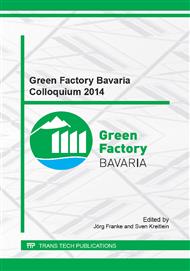p.3
p.9
p.15
p.21
p.27
p.35
p.41
p.47
E|Benchmark - Approaches and Methods for Assessing the Energy Efficiency of the Industrial Automated Product Manufacturing
Abstract:
This paper introduces a method for the assessment and evaluation of energy efficiency of the manufacturing processes in the production as well as a corporate and cross-industry comparison. Already today, energy-related characteristic value systems are used, which are related to the energy consumption of large electronic household appliances or are focusing on their production facilities. The energy efficiency value is a newly developed indicator and will provide valuable information about the energy efficiency of the production of various products, production operators, and consumers. In the following, the energy efficiency value, which is based on the approach of minimal value calculation, is presented in detail. The basic idea is the comparison and evaluation of energy efficiency based on the ratio of the theoretically required energy consumption to the actual energy consumption. Depending on the analysis of influencing factors, a model highlighting their dependencies could be established. The developed system hinges on a successive calculation of the minimum value. Each of these minimum types can be put in relation to the measured energy consumption. However, depending on the chosen basis, the conclusion and focus of the calculated key figure may vary. By using the real minimum as a basis, the actually existing energy savings become visible. The method will be put to the test through an exemplary application for processes in the fields of cutting technologies. This course of action allows for the validation of the developed energy efficiency value and reveals the potential of this method.
Info:
Periodical:
Pages:
15-20
Citation:
Online since:
October 2014
Authors:
Price:
Сopyright:
© 2014 Trans Tech Publications Ltd. All Rights Reserved
Share:
Citation:


